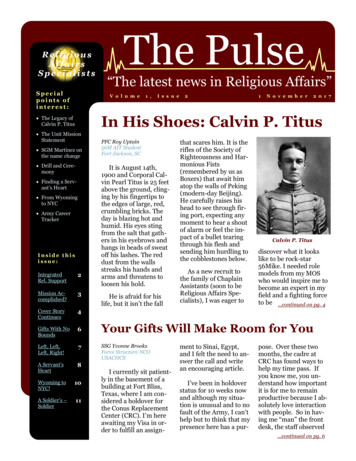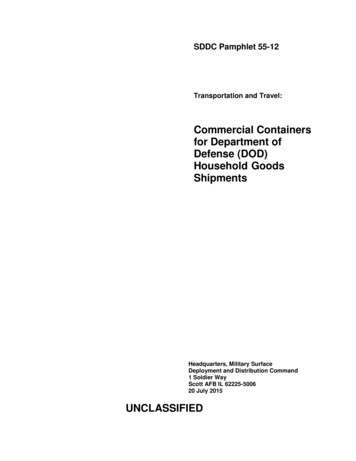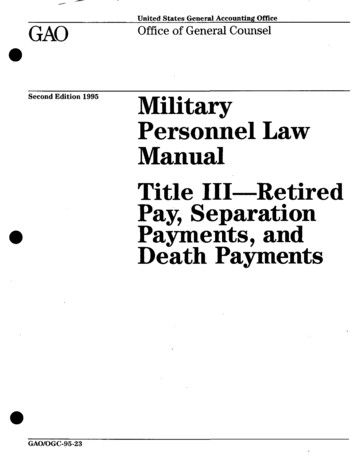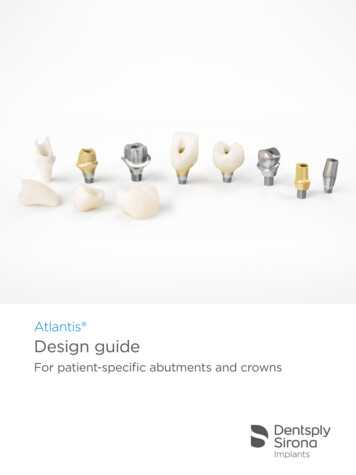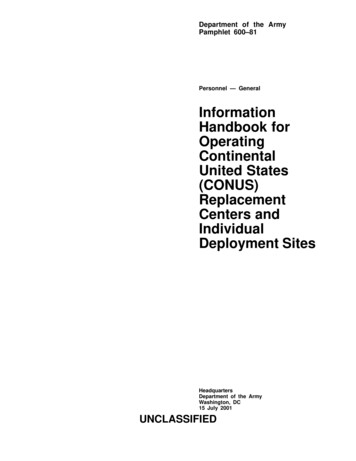
Transcription
Department of the ArmyPamphlet 600–81Personnel — GeneralInformationHandbook forOperatingContinentalUnited States(CONUS)ReplacementCenters andIndividualDeployment SitesHeadquartersDepartment of the ArmyWashington, DC15 July 2001UNCLASSIFIED
SUMMARY of CHANGEDA PAM 600–81Information Handbook for Operating Continental United States (CONUS)Replacement Centers and Individual Deployment SitesThis is a new pamphlet thatoPrescribes a new DA Form 7425 (Personnel Readiness and Deployment Checklist)which provides continental U.S. replacement centers and individualdeployment sites with a standardized checklist for planning, operating, andexecuting CRC operations (para 2-11f).oIncorporates the terms “redeployment” (para 3-13) and “reintegration” (para3-15).oIncorporates “individual deployment site” concept along with background,functions, structure, and installation support (chap 6).
Department of the ArmyPamphlet 600–81HeadquartersDepartment of the ArmyWashington, DC15 July 2001Personnel — GeneralInformation Handbook for Operating Continental United States (CONUS)Replacement Centers and Individual Deployment SitesHistory. This printing publishes a newDepartment of the Army pamphlet.Summary. This pamphlet provides information and procedures for CONUS replacement centers (CRC) and individualdeployment sites (IDS). This pamphletfalls under the policy guidance of AR600-8-101, Personnel Processing (In–,ContentsOut–,Soldier Readiness, Mobilization, andDeployment Processing).agency who holds the grade of colonel orthe civilian equivalent.Applicability. This pamphlet applies tothe Active Army, the Army NationalGuard of the United States (ARNGUS),U.S. Army Reserve (USAR), and civilianpersonnel. It applies to all military andcivilian personnel and organizations involved with CRC management, administration, and training. It also applies to allmilitary and civilian personnel that willprocess through a CRC/IDS. During amobilization, procedures contained in thispamphlet may be modified by the proponent to support policy and proceduralchanges as necessary.Suggested improvements. Users areinvited to send comments and suggestedimprovements to this pamphlet. Send thisinformation on a DA Form 2028 (Recommended Change to Publications and BlankForms) directly to HQDA (DAPE-PRO),300 ARMY PENTAGON, WASHINGTON, DC 20310-0300.Proponent and exception authority.The proponent of this pamphlet is theDeputy Chief of Staff for Personnel(DCSPER). The proponent has the authority to approve exceptions to this pamphletthat are consistent with controlling lawand regulation. The DCSPER may delegate this approval authority in writing, toa division chief within the proponentDistribution. This publication is available in electronic media only and is intended for command levels A, B, C, Dand E for Active Army, Army NationalGuard of the United States and the U.S.Army Reserve. This publication containspolicy and operational information that isfor official Government uses only.(Listed by paragraph and page number)Chapter 1Introduction, page 1Purpose 1–1, page 1References 1–2, page 1Explanation of abbreviations and terms 1–3, page 1Mission 1–4, page 1Background 1–5, page 1Chapter 2Command Relationships and Functions, page 1Section IHeadquarters, Department of the Army and Field Operating Agencies (FOA), page 1Deputy Chief of Staff for Operations and Plans (DCSOPS) 2–1, page 1The Deputy Chief of Staff for Personnel (DCSPER) 2–2, page 2The Deputy Chief of Staff for Logistics (DCSLOG) 2–3, page 2DA PAM 600–81 15 July 2001UNCLASSIFIEDi
Contents—ContinuedTotal U. S. Army Personnel Command (PERSCOM) 2–4, page 2Section IIMajor Army Commands (MACOMs), page 3U.S. Forces Command (FORSCOM) 2–5, page 3Training and Doctrine Command (TRADOC) 2–6, page 3Combined Arms Support Command (CASCOM) 2–7, page 4U.S. Army Soldier Support Institute (SSI) 2–8, page 4Section IIICONUS Replacement Centers (CRC), page 4Peacetime 2–9, page 4Mobilization 2–10, page 4Section IVCONUS Replacement Center Battalion (CRCB), page 8CRCB commander 2–11, page 8S1 Officer 2–12, page 11Operations (S2/3) officer 2–13, page 13S4 officer 2–14, page 13The CRC commander 2–15, page 13Chapter 3Execution, page 14Section IConcept of the Operation, page 14General 3–1, page 14Locations 3–2, page 14The process 3–3, page 15Section IIMobilization, page 16General 3–4, page 16Graduated mobilization response (GMR) 3–5, page 16Theater engagements 3–6, page 16Wartime replacement operations execution 3–7, page 16Time-Phased Force and Deployment Data (TPFDD) 3–8, page 17Section IIIDeployment, page 18General 3–9, page 18CRC battalion 3–10, page 18Section IVSustainment, page 19General. 3–11, page 19Manning 3–12, page 19Section VRedeployment, page 19General 3–13, page 19Redeployment requirements 3–14, page 19Section VIReintegration, page 20iiDA PAM 600–81 15 July 2001
Contents—ContinuedGeneral 3–15, page 20Reception of NRP 3–16, page 20Reintegration processing 3–17, page 20Special operational considerations for VIP(s) 3–18, page 21Welcome home ceremonies 3–19, page 21Section VIIRelease From Active Duty (REFRAD), page 21General 3–20, page 21Coordination 3–21, page 21Points of contact 3–22, page 22Chapter 4Installation Support Functions, page 22The installation commander 4–1, page 22Director of Plans, Training, and Mobilization (DPTM) or equivalent 4–2, page 23Installation AG/MPD and/or Director of Personnel and Community Activities (DPCA) or equivalent 4–3, page 23Director of Installation Support (DIS)/Director of Logistics (DOL) 4–4, page 23Cdr, Installation U.S. Army Medical Department Activity (MEDDAC) 4–5, page 24Cdr, Installation Dental Activity (DENTAC) 4–6, page 24Director of Information Management (DOIM) 4–7, page 24Director, Civilian Personnel Advisory Center (CPAC) 4–8, page 24Public Affairs Officer (PAO) 4–9, page 25Installation Chaplain 4–10, page 25Chapter 5Exercises, page 25General 5–1, page 25Mobilization exercises 5–2, page 25Training requirements 5–3, page 25Training tools 5–4, page 26Chapter 6Individual Deployment Site (IDS), page 26Introduction 6–1, page 26Background 6–2, page 26IDS concept 6–3, page 26IDS functions 6–4, page 26IDS structure 6–5, page 27Installation support 6–6, page 27Summary 6–7, page 27AppendixesA.References, page 29B.CRC Activation Plan, page 31C.ROAMS Status Codes, page 32D.Sample Soldier and Civilian Deployment packet, page 33Table ListTable 3–1: CRC Typical Flow Schedule, page 18Table 4–1: Designated POE/POD, page 24DA PAM 600–81 15 July 2001iii
Contents—ContinuedFigure 3–1:6–1:Sample CRC Organization and Structure., page 5Current CRC Assignment, page 6CRC Receives/Conducts Example, page 7CRC Installation Organization, page 7Sample Commander’s Deployment SITREP, page 9Sample Commander’s Re-Deployment SITREP—Continued, page 10Sample Deployment Packet, page 12CRC’s, page 15IDS and CRC Comparison, page 28GlossaryivDA PAM 600–81 15 July 2001
Chapter 1Introduction1–1. PurposeThis pamphlet provides information for operating continental United States (CONUS) replacement centers (CRC) andindividual deployment sites (IDS). The pamphlet also establishes procedures for planning and executing CRC operations, and includes detailed procedures as required by AR 600-8-101, FM 12-6 (Army Personnel Doctrine, ArmyTraining Evaluation Program, ARTEP, 12-606-61/Mission Training Plan (MTP), and instructions on providing accountability of all non-unit related personnel (NRP) to and from the theater. Finally, this pamphlet also provides a means forstandardizing theater and redeployment requirements to conserve resources. Most of the pamphlet is devoted to CRCoperations. Specific IDS guidance is provided in chapter 6.1–2. ReferencesRequired and related publications and prescribed and referenced forms are listed in appendix A.1–3. Explanation of abbreviations and termsAbbreviations and special terms used in this pamphlet are explained in the glossary.1–4. MissionThe CRC and IDS validate non-unit-related personnel for deployment, resolve non-deployable conditions, providesustainment of NRP flow to the theater, and receive and reintegrate NRP on redeployment. The initial CRC/IDSmission was to ensure Army NRP were fully prepared for deployment. The CRC/IDS mission scope has been expandedin recent years to include individuals from all Services. This includes all Department of Defense (DOD) civilianpersonnel, contract personnel, and employees of the National Red Cross, and the Army/Air Force Exchange Service(AAFES). The CRC and IDS are activities providing theater specific deployment processing and do not perform agarrison support unit (GSU) or reception station’s responsibility to mobilize Reserve component (RC) soldiers.1–5. Backgrounda. Throughout the history of military deployments (peacetime and war), the theater consistently inherited problemsassociated with incomplete deployment processing; for example, pay, issue of theater specific clothing and equipment,briefings, immunizations, training, and personnel requirements such as family care plans. Not all installations andcommand headquarters had the ability to properly prepare their personnel for deployment. It was also cost andmanpower prohibitive for installations to maintain large supplies of stocks, weapons, and medical supplies in anticipation of a mobilization. In June 1987, the Vice Chief of Staff of the Army approved the CRC concept to support majorregional contingencies (MRCs), now called major theater war (MTW). The concept was tested and proven with thesuccessful use of three CRCs during Operation DESERT STORM in the early 90’s deploying over 20,000 NRP in 6months.b. The shift in National military strategy in the early 1990’s transitioned the military from a cold-war threat tosupport numerous small scale contingency (SSC) operations around the globe. Although the volume of individual flowdid not support a full CRC operation, the need to centralize flow and standardize support for these SSCs becameapparent during operations in Somalia.c. The DCSPER developed the concept for a permanent location arrangement to manage individual flow duringpeacetime operations and limited contingencies. In April 1998, the DCSOPS, approved an IDS concept to support lowlevel, low intensity specified operations.d. The IDS and CRC concepts were implemented to combat the numerous problems associated with receivingindividuals directly from their home station into a theater of operations without having been adequately prepared fordeployment. CRC locations were determined by: administrative, billeting, bed (hospital), warehouse (for theaterspecific equipment and weapons (arms room) space; ranges, infrastructure, locations of schoolhouses/training sites;central initial issue point (CIIP) and central issue facility (CIF); and aerial ports of embarkation (APOE).Chapter 2Command Relationships and FunctionsSection IHeadquarters, Department of the Army and Field Operating Agencies (FOA)2–1. Deputy Chief of Staff for Operations and Plans (DCSOPS)The DCSOPS serves as the overall Army proponent for policy, plans, and doctrine in support of military operations, toDA PAM 600–81 15 July 20011
include mobilization, deployment, sustainment, redeployment, reintegration, and release from active duty. TheDCSOPS—a. Provides resource priority for replacement operations.b. Provides authority for flow of NRP, projected not more than 90 days out.c. Ensures that ODCSPER includes appropriate CRC RC units in each Presidential Reserve Call-up (PRC) increment (see para 3-5b).d. Issues unit activation authority in coordination with the DCSPER to ensure CONUS replacement center battalions(CRCB) have, when possible, no less than 30 days train-up time at the installation before scheduled NRP flow.2–2. The Deputy Chief of Staff for Personnel (DCSPER)The ODCSPER develops personnel policy and guidance for the mobilization, deployment, employment, redeployment,and reintegration of total Army personnel. The DCSPER -a. Develops personnel policy and guidance for the mobilization, deployment, employment, redeployment, andreintegration of Army personnel.b. Serves as the staff proponent for CRC and IDS operations.c. Coordinates funding for CRC exercises and execute HQDA level exercise coordination.d. Provides recommended CRC installations and locations for OPLANs.e. Monitors CRC and IDS operations.f. Implements NRP distribution and assignment actions to support contingency wartime operations through TotalArmy Personnel Command (PERSCOM).g. Adequately resources CRC and IDS operations.h. Through PERSCOM, provides DCSOPS with CRCBs required for each OPLAN proposed call-up list.i. Provides the DCSLOG with a forecast requirement for organizational clothing and individual equipment (OCIE),chemical defense equipment (CDE), and weapons.j. Designates essential units mess (EUM) as soon as CRC is activated. Officers and civilian personnel will pay thebase amount. There is no messing charge for enlisted soldiers.k. Provides /release from active duty (REFRAD) guidance insupport of specified operations and joint exercises.l. Is the final decision authority for CRC activation in coordination with the DCSOPS and TRADOC.m. In coordination with the DCSOPS, provides TRADOC with operational requirements for CRC exercises.2–3. The Deputy Chief of Staff for Logistics (DCSLOG)The DCSLOG coordinates with U.S. Army Materiel Command (AMC) and appropriate agency’s issue of OCIE/CDE/weapons as required, to support CRC operations. The DCSLOG also provides guidance on accountability and visibilityof weapons issued from the CRC.2–4. Total U. S. Army Personnel Command (PERSCOM)PERSCOM —a. Manages NRP distribution planning and execution for all operations.b. Controls and coordinates filler and casualty replacement flow through the IDS/CRC(s) to the ports of embarkation(POE), in support of approved Joint Chiefs of Staff (JCS) OPLANs.c. Directs the assignment of NRP flowing through IDS/CRC(s).d. Coordinates POE designations to support each IDS/CRC location and to obtain required strategic airlift supportfor NRP flow.e. Ensures that the CRCB provides advance arrival reports (AAR) of projected deployers to the theater’s receptionactivity in advance of scheduled arrival. The report will include a complete standard name line information ((name,rank/grade, Social Security Number (SSN)), and military occupational specialty (MOS), area of concentration (AOC)/occupation category code.f. Provides personnel assistance points (PAP) at each designated CRC/APOE to act as the Army’s primary representative for managing all aerial port operations related to the movement of NRP. This includes arrival processing,coordinating loading procedures, and preparing the final manifest for input into the PERSCOM designated automatedsystem within 1 hour of an aircraft’s departure. The PERSCOM system is currently called the Replacement OperationsAutomated Management System (ROAMS).g. Develops, maintains, determines, and coordinates CRC and IDS operational automated data processing (ADP)systems such as ROAMS, which interfaces with TAPDB.h. Maintains one automated system consisting of three modules supporting this mission: Automation of the TheaterShelf Requisitioning Process (AUTOREP), NRP Flow Computer Assisted Program (FLOWCAP) and Automation ofthe Casualty Analysis Process (AUTOCAP). These modules are explained below.(1) AUTOREP generates filler and casualty replacement requirements. The program stratifies projected aggregate2DA PAM 600–81 15 July 2001
casualty information by personnel category, area of concentration, military occupation specialty, and rank/grade topredict the number of replacements required over time. Its product is known as the “shelf requisition.”(2) FLOWCAP is an application used by PERSCOM and the CRC(s). The program is used to schedule, control, andtrack flow of replacements from the CRC to the theater. Applications also provide manifest data for the AMC, advancearrival information for the Army component commander and generate internal reports for the CRC to manage andprocess replacements.(3) AUTOCAP compares actual casualty data and OPLAN modifications against projected and actual flow ofcasualty replacements and fillers. It also allows the Army component commander to adjust projected requirements.i. Cdr, PERSCOM ATTN:TAPC-PLO-TC controls the PAP, which provides administrative and logistical support tosoldiers, DOD civilians, and their families en route to and from overseas locations and coordinate use of strategic airliftrequired for the deployment of NRP from a CRC to the theater of operations. Cdr, PERSCOM (TAPC-PLO) —(1) Ensures continuity in the manner in which NRP are moved.(2) Validates movement requirements (personnel increment number (PIN) or unit line numbers (ULN) with thesupported CINC and coordinates strategic airlift with the CINCs, U.S.Transportation Command (USTRANSCOM), andAMC.(3) Coordinates with AMC and the carrier for resolution of problems and changes in requirements.(4) Enters scheduling data into ROAMS for dissemination to all users to include PAP, CRC, theater, and theArrival/Departure Airfield Control Group (ADACG).(5) Coordinates with the CRCB for command and control of passengers while in the POE.(6) The PAP is located at the POE and does the following:(a) Ensures the CRC designates an NRP as a troop commander for command, control and accountability ofpersonnel once aboard the aircraft. Accountability on the aircraft remains the responsibility of the troop commanderdesignated by the CRC until arrival at the AO.(b) Coordinates responsibilities with the ADACG.(c) Designates seating allocations for each loading station.(d) Coordinates with downline stations.(e) Coordinates with the ADACG.Section IIMajor Army Commands (MACOMs)2–5. U.S. Forces Command (FORSCOM)FORSCOM through U.S. Army Reserve Command (USARC) provides the command and control of CRCBs inpeacetime. FORSCOM—a. Provides logistical and administrative funding support, planning, programming, budgeting, and allocation ofresource guidance to the USARC.b. Allocates equipment and force structure to the CRC battalions and companies in coordination with Training andDoctrine Command (TRADOC), ODCSPER, and ODCSOPS.c. In coordination with TRADOC, provides training guidance to CRCB units.d. Monitors and maintains CRCBs and CONUS Replacement Center Company (CRCCs) readiness which augmentCRC operations.e. Resources, and evaluates required unit training, inactive duty training (IDT), and active duty for training (ADT)exercises, to ensure CRC replacement units are capable of performing wartime missions.f. Supports CRC mission during peacetime training and exercises, to include individual readiness training (IRT),when required.g. Provides command and control of activated USAR CRCB/CRCCs until arrival at the CRC installation.2–6. Training and Doctrine Command (TRADOC)TRADOC is the Army’s executing agent for IDS/CRC and—a. Develops and evaluates required CRC training per Army Training Evaluation Program (ARTEP). On activation,command and control of the CRC unit converts from FORSCOM to TRADOC. TRADOC also assumes command andcontrol of the CRCB and provides base operations support (BASOPS) on arrival at the designated CRC site.b. Develops and publishes IDS/CRC operations, doctrine and training materials.c. Executes CRC operations at CRC designated sites.d. Ensures funding for minimal stockage levels of OCIE/CDE for issue at IDS/CRC installations for operations andexercises.e. Coordinates with ODCSLOG to ensure adequate OCIE/CDE/ weapons (Army Operation Projects Stocks) andlogistical support.DA PAM 600–81 15 July 20013
f. Budgets for and provides funding support for the CRC mission during peacetime training and mobilizationexercises through ODCSOPs.g. Directs TRADOC staff and installations to execute Army plans for specified operations and exercises.h. Develops and provides a 5-year exercise plan in coordination with the DCSPER, USARC, CRC installations, andCRC battalions.i. Ensures IDS mission-funding requests are submitted annually in the TRADOC POM.j. Ensures conflicts between CRC units and installations are addressed within installation and USARC channels.k. Staffs and approves/disapproves NRP waiver requests. Those waivers in question are coordinated with ODCSPER(DAPE-PCC), as necessary.l. Ensures CRC installations incorporate CRC operations in installation mobilization plan.m. Coordinates with ODCSLOG to establish procedures for the call-up of Army operational project stocks insupport of CRC and IDS operations.n. Provides CRC mission statement to installations.o. Executes IDS operations at Ft. Benning, GA.p. Provides IDS mission statement to Ft. Benning, GA.2–7. Combined Arms Support Command (CASCOM)CASCOM makes recommended changes to resource documents Modified Table of Organization and Equipment(MTOEs) for CRC replacement battalions and companies.2–8. U.S. Army Soldier Support Institute (SSI)a. As branch proponent for CRC operations, reviews and monitors resource documents.b. Includes doctrine for CRC and IDS operations in appropriate field manuals and officer and NCO professionaldevelopment courses.c. Develops and maintains ARTEP MTPs for CRCBs and CRCCs.Section IIICONUS Replacement Centers (CRC)2–9. PeacetimeDuring peacetime, the USAR CRCBs and companies are under the command and control of USARC and subordinateArmy Reserve support commands (RSC)/Reserve support groups (RSG). On execution of PRC, or mobilization,command lines are as follows: CRCBs exercise command and control of CRC companies (CRCCs) per theirWARTRACE. The CRC battalion reports to the installation commander on arrival at the CRC installation.2–10. MobilizationDesignated CRC units will move to their perspective designated CRC installation(s) per Planning Association 800Document (PLASSN-800) and per FORSCOM Mobilization and Deployment Planning System (FORMDEPS) andTRADOC Mobilization Operations Planning and Execution System (TMOPES).a. On arrival, CRC becomes part of the installation support activity. The CRCB and supporting CRCC(s) areorganized at Authorized Level of Organization (ALO) Cadre (C). The CRC Battalion and Company MTOE is at http://www.usafmsardd.army.mil/toeheader.cfm. (Click on 12, AG/BAND and look for: 12906L000, HHC, Repl BN (CONUS) and 12907L000, Repl CO, (CONUS).) The CRC organization and structure is at figure 2-1. The CRC organizationand CRC alignment is at figure 2-2.b. The CRCB provides command and control, coordinates support, and manages the flow of NRP. A unit coordinates directly with the installation for support and with PERSCOM for personnel movement flow.(1) Mission. Deploy civilian personnel and “fit to fight” soldiers from CONUS to the theater of operations asquickly as possible. The battalion commander is responsible to the installation commander for certifying NRPdeployability and the installation commander is the validation authority.(2) Management of personnel. CRCB manages personnel processing by scheduling and monitoring the status ofNRP and PIN groups being controlled by CRCC. The battalion may designate a holding unit to control NRP or PINgroups for whom movement delays develop.(3) Flight delays. Coordinate for contingency plans for interim logistical support and morale and welfare activitiesfor personnel with delayed flight departures.(4) Coordination. Conduct necessary coordination with the installation for establishing the CRC, processing NRPand ensuring mission accomplishment. (See figs 2-3 and 2-4.)(5) Critical tasks. Critical tasks, which must be completed, include the following:(a) Prepare and coordinate a daily processing schedule with the installation.4DA PAM 600–81 15 July 2001
(b) On activation of CRC, provide daily status reports to PERSCOM on CRC reception capability and equipmentavailability. This report will include, as a minimum, the total number of NRP being processed.(c) Provide computer-generated lists of NRP (allocated by platoon) to the company for processing; provide PINgroup number, the Available to Load Date (ALD) and time for the PIN group.(d) Certify completion of readiness processing requirements and conducts deployment (theater specific) processing.(e) Ensure PIN group leaders are appointed and properly briefed on responsibilities.(6) Uniform Code of Military Justice (UCMJ) authority. The CRCB exercises UCMJ authority over military NRPprocessing through the CRC. The CRC battalion has overall responsibility for NRP from the time of their arrival at theCRC until their departure from the APOE.Figure 2–1. Sample CRC Organization and Structure.DA PAM 600–81 15 July 20015
Figure 2–2. Current CRC Assignment6DA PAM 600–81 15 July 2001
Figure 2–3. CRC Receives/Conducts ExampleFigure 2–4. CRC Installation OrganizationDA PAM 600–81 15 July 20017
Section IVCONUS Replacement Center Battalion (CRCB)The CRCB is a resource provided by the Army Reserve to assist an active duty installation’s mission to conduct CRCoperations.2–11. CRCB commanderThe relationship between the installation and the CRCB commanders is the same as with any other installation unitcommander. The CRC battalion commander executes CRC operations, including the following:a. Certification of military and civilian personnel readiness and deployment processing so that the installationcommander can validate NRP for deployment.b. Command and control of NRP.c. Managing a 24-hour, 7-day a week operation.d. Conducting commander’s welcome/orientation briefing to cover deployment-processing scheduling/activities.e. For security measures establishing sign-in and identification procedures for visitors.f. Certifying readiness processing per AR 600-8-101, chapter 4, using the Personnel Readiness and DeploymentChecklists (DA Form 7425), available in electronic version only.g. Providing a daily SITREP report NLT 2000 local time to PERSCOM with copy to HQ TRADOC, ATTN: ATCSEOC and ODCSPER, DAPE-PCC. (See figs 2-5a and 2–5b.)h. Reporting or reassign non-deploying personnel to the Installation AG/MPD for separation or reassignment.i. Certifying family care plans before deployment.j. Ensuring complete accountability of weapons by serial number is conducted during deployment and reintegration.The SSN will be placed on a corresponding checklist.k. Conducting daily staff meetings to attempt to resolve issues and concerns and to plan for events for the next dayand/or week.l. Coordinating with the following:(1) With the installation for completion of deployment requirements for NRP and clear for departure within a 5-daycycle.(2) Theater specific issue of clothing and equipment.(3) Theater specific training to include weapons zero/qualification and protective mask familiarization.(4) Medical/dental screening and theater immunizations for deployment and REFRAD, to include Human Immunodeficiency Virus (HIV) testing, medical screening, and pregnancy tests as required.(5) For dental exams as required. Dental classifications 3 and 4 receiving treatment will not deploy until treatment iscompleted or unless otherwise approved by the installation commander with recommendation from Dental Activity(DENTAC) in grade 06 or above. When approved, treatment may be authorized in the AO and the individual maydeploy.(6) With Army Community service (ACS) for NRP family support deployment briefings (includes safety, terroristand medical threat, public affairs policy, customs, and courtesy).(a) Ground movement for NRP to the POE.(b) Ground movement for NRP from point of debarkation (POD) to the CRC.(c) For command control of individual losses and VIPs received from the theater.(d) For redeployment debriefs (includes security measures).(e) Turn-in of specified clothing and equipment on redeployment.(f) Finance operations for deployment and reintegration.(g) For religious support through the Installation.8DA PAM 600–81 15 July 2001
Figure 2–5. Sample Commander’s Deployment SITREPDA PAM 600–81 15 July 20019
Figure 2–5. Sample Commander’s Re-Deployment SITREP—Continued10DA PAM 600–81 15 July 2001
2–12. S1 Officera. Provides typical staff support for the battalion cadre.b. Responsible for the command and control of all holdovers.c. For CRC operations and NRP support, coordinates the following:(1) Administrative support for the battalion cadre with the installation DPCA during the establishment of the CRCand during CRC operations.(2) With installation AG, Staff Judge Advocate (SJA), Chaplain, Medical Activity (MEDDAC), DENTAC, PAO,Finance, Morale, Welfare and Recreation Program (MWR), Inspector General (IG), and Provost Marshal (PM) andCPAC.(3) And monitors the MWR Program to include: AAFES support, recreational media (magazines, newspapers,books, television and movies), pay telephone support, and fitness center support.(4) With the Installation Adjutant General (AG)/MPD to store/maintain records of deployed NRP and to ensureReserve component soldiers are accessed into Standard Installation/Division Personnel System (SIDPERS).d. Monitors personnel, postal and replacement status reports.e. Inspects subordinate units, as required by the commander.f. Develops and monitors the battalion Safety Program, Risk Management Program, Drug and Alcohol AbuseProgram, legal support, and counterintelligence support.g. Ensures:(1) All incoming personnel (cadre and NRP) are briefed on safety.(2) Deployment packets are established and appropriate documents are included.(3) All NRP are medically prescreened.(4) Prepares request for orders (RFO) for the installation AG to cut orders to return NRP to home station. (A sampleof IRR training orders is at fig 2-6.)(5) Reports CRCB unit SIDPERS strength data to installation SIDP
Contents—Continued Figure List Figure 2-1: Sample CRC Organization and Structure., page 5 Figure 2-2: Current CRC Assignment, page 6 Figure 2-3: CRC Receives/Conducts Example, page 7 Figure 2-4: CRC Installation Organization, page 7 Figure 2-5: Sample Commander's Deployment SITREP, page 9 Figure 2-5: Sample Commander's Re-Deployment SITREP—Continued, page 10




